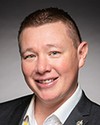I come from a context where it's indigenous land regardless. We just have to act like it's our land, like we have from time immemorial.
Public policy-makers have such a challenge, because 90% of the population lives within 100 kilometres of the border. That population is aging. There's more pressure on those at this table and on your friends in the House to devote more money towards infrastructure and health care in the south.
What's going to drive the economy in the future is access to critical minerals in northern Canada. We need to start creating infrastructure driven by indigenous communities like we've done to unlock deposits of critical minerals. What we're doing now is asking resource companies to find super-deposits, because there's no infrastructure. The economics have to be in these massive super-deposits, which then have an inherently higher environmental risk. That's the vision. I think you can use the example we've set and the nation has set.
Our nation went out and looked at what lands we could first go to for hunting, trapping and fishing purposes. Those are the first lands we went after. As Mr. Calla said, that's the heart of indigenous peoples. It's the lands and where they grew up. Then they took the next step and said they need own-source revenue. We have this high-grade uranium in our backyard that is going to last for 100 years, but we need to now move and buy more lands to create economic development opportunities.
It needs to change from a rights and title discussion to strictly a business discussion. You look in some places, like our cousins in the United States, the Seminole Tribe.... They just bought the Mandalay Bay down in Las Vegas. They didn't do that because it's a rights and title discussion. They did it because it was a good business play.
Indigenous communities and indigenous business leaders like me are moving forward in that context. Land is at the core of how we can get to that and create value out of land.



